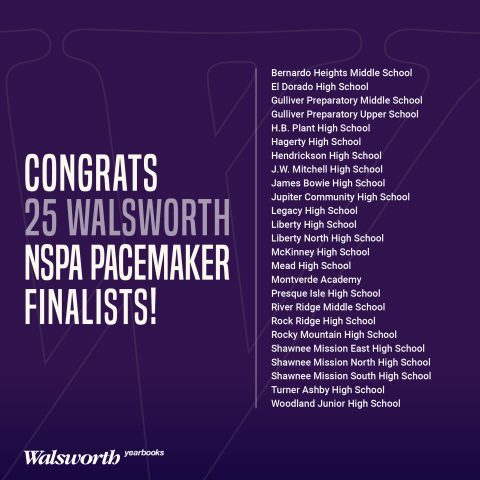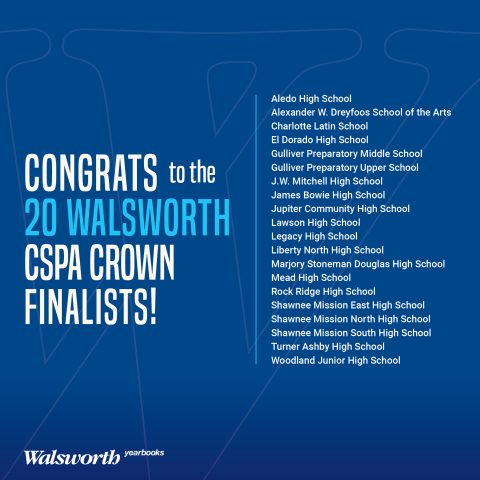The book gets done and distributed and it’s instantly time to start thinking about next year. That was fast.
It’s time to get the creative juices flowing and start gathering inspiration and contemplate what the story of 2020 at your school will be.
 Part One – Story Quest
Part One – Story Quest
What story do you want to tell in 2020?
This is where the journey really begins. Never forget that story always comes first. A modern yearbook is a storybook that will tell the story of one year in as much depth as possible, within the number of pages you have.
Discovering that story most likely won’t happen in the spring before the year actually starts, but you can begin gathering ideas of what that story might be.
Begin by asking questions together as a staff and editorial board. What will be new? Are there any major changes coming? If everything seems the same, you might want to examine the character of the individual student or the qualities that make your school unique.
Gather words and phrases. Begin the process by collecting possible words and phrases that connect to your school and your students. What are students saying? What phrases are used on television? Listen to commercials from the local news to ESPN to MTV and take notes. The important thing is to gather as many words and phrases as you can. You want words that will inspire in-depth coverage as you tell the story.
What will your voice and tone be? What are you thinking will be the voice and tone of your story and the year to come? Classic? Fun and funky? Uncertain? Celebratory? Are you feeling pride for your school and community? Will you focus more on the individual student? What kinds of stories do you plan to emphasize?
Let it percolate. Once you get a bunch of words and phrases you like, let them percolate. As the year gets closer you will have a better sense of the direction of the year and your story will come into clearer focus.
Set a deadline. For my yearbook staffs, our theme story deadline was always camp in July. That was when we absolutely needed to have our theme selected so we could begin developing and deciding on the look of the book. Though the choice was always ours, at camp we could bounce our ideas off all the experts there and get their opinion on what they felt was fresh and fit us best.
Capture it in writing. As your story for the year starts to take shape, explain it by writing about it. Explain in words what the story is and how you plan to begin developing it. Include as many specifics as you can that relate to that story. Take a stab at writing a beginning of your theme copy. However you approach it, you must write about it. Write. Explain. Capture specifics. If you can’t write about it easily, it’s probably not a great theme.
Even then be flexible. You want to avoid this if possible, but even after school starts you can still change your theme as your year really gets underway. There are always a couple of schools who attend Walworth’s Elite Weekends who completely abandon their themes once they realize it just isn’t working or can’t really be developed in depth.
In 2015-16, Renee Burke and her staff at Boone High School in Orlando, Florida, totally changed their theme to “You Just Don’t Know Us” after the first deadline. It was a struggle, but it turned out to be one of the very best books that year.
Part Two: Design Quest
At the same time you are gathering and discussing the story focus of your year, you need to begin gathering design inspiration for what the look of your book will be. Too often schools focus too much on design in the early stages and their story gets lost or is never developed. That said, you still need to be gathering a wealth of design ideas.
 It’s B and N time. The best place to start your design quest for a new book will most likely be a field trip to Barnes and Noble. This can be the first task of your newly selected editorial team. Give them specific directions about what they are looking for, have them shoot photos of what they find on their phones, and then gather them on a power point or mood board for future reference.
It’s B and N time. The best place to start your design quest for a new book will most likely be a field trip to Barnes and Noble. This can be the first task of your newly selected editorial team. Give them specific directions about what they are looking for, have them shoot photos of what they find on their phones, and then gather them on a power point or mood board for future reference.
Buy the magazines you love. Once you have discovered specific magazines with a design aesthetic you connect with, buy them digitally or in hard copies. An app like Zinio is a great place to purchase magazines at discounted prices.
Design portfolios for everyone. Everyone on staff should have an ongoing design portfolio where they gather and collect design resources and inspiration. Some staffs collect ideas on Trello, others use private Pinterest boards, and others just save ideas onto a PowerPoint show. If a staffer were on yearbook staff for four years, imagine all the resources they will have gathered.
Check out ISSUU. Though it does not have as many free resources as it used to, you can still find magazines and other publications that are worth digging for. Particularly good are the college promotional look books you can view and download.
Get a library card and check out what your local library has available. Most libraries will give you access to their magazine libraries if you have a local library card. Mitch Ziegler from Redondo Union High School in Redondo, Beach California, and his staff found their 2019 font and design inspiration in Allure magazine they found on their library site. They contacted the magazine’s designer and found what font he used and have used one like it in their design package.
Pinterest. There are lots of great ideas to be discovered on Pinterest. Just take a careful look on how old they are. Some older inspiration there has already appeared in many yearbooks. The key is to use what you find as a starting point. Drill down to find other resources connected to your first find or find out who created them and branch out from there. Use what you love, but be careful.
Design portfolio sites. There are many sites out there where graphic designers or potential graphic designers post their stuff to get jobs or find a wider audience for their work. Check out Behance.com, Dribbble.com, FIDM.com and spark.adobe.com among many others.
Graphic design firms and professional designers. When you find a graphic design look you like, research to find the name of the designer and the company they work for. I am always amazed at the depth some yearbook designers have gone to when they are determined to make a connection. Often these designers are very helpful and will tell you what fonts they used or what other fonts you could use if theirs is proprietary. One staff I know were invited to meet the designer who inspired their book when they were in New York for CSPA.
The team behind 2020 presidential candidate Pete Buttigieg released a design tool kit. If you haven’t yet, take a look. It’s an incredible example of design and branding. From there, one yearbook staff dug deep and found the graphic design firm who created it hyperakt.com, which opened up another wealth of information.
Find your fantastic font. Typography is probably the easiest and most dynamic way to personalize the look of your book. A great font can put you on an amazing design trajectory and a tired, over used one can make your book seem dull and old.
As a yearbook designer you need to really love your font package. It should bring joy every time you see it. In your clip file start gathering fonts and types of fonts you love. Also look through a font clearing house site like myfonts.com to see what fonts are popular and ones that might fit the voice and tone of your theme story.
If you are on a tight budget several web sites offer free fonts you can download. Check out dafont.com and fontsquirrel.com and discover many other free font sites that are available to you.
Watch more TV. When I have been at the gym lately, I started noticing all the incredible graphics that were appearing on the multiple monitors overhead. Particularly interesting are the typography, logos, and words and phrases used by ESPN and MTV. When you get home, just record a couple of hours of ESPN or MTV and then start taking screen shots or photos of what you like. It’s so easy to stop where you like and fast forward through what you don’t. These designs are about as current and fresh as anything can be.
 Find your own resources. There are thousands of places out there to find inspiration. I am always amazed what staffs and advisers are finding that I have never even heard of. You can be one of the ones who finds fresh, new, never-been-done looks to inspire you. Just get looking and start digging deep.
Find your own resources. There are thousands of places out there to find inspiration. I am always amazed what staffs and advisers are finding that I have never even heard of. You can be one of the ones who finds fresh, new, never-been-done looks to inspire you. Just get looking and start digging deep.
Get inspired and inspire others. However you approach the task of finding your story and designs for the book ahead, start by gathering what inspires you. It will pay off by helping you create a unique book that best tells the story of your year that will undoubtedly inspire others.





